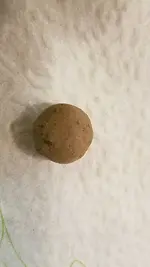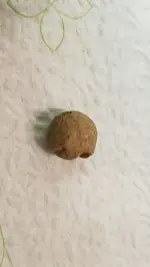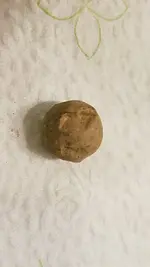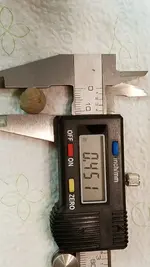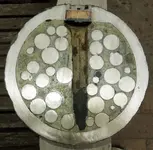You are using an out of date browser. It may not display this or other websites correctly.
You should upgrade or use an alternative browser.
You should upgrade or use an alternative browser.
✅ SOLVED Dug this on a ridge near the Fort Chiswell, Va. area
- Thread starter RVRoamer74
- Start date
- #2
Thread Owner
Though the one set of markings appear to resemble the letter C and number 7, is it possible that they could be teeth marks? Just wondering. I know of some musket balls that were found from the War of 1812 that had been chewed, supposedly to keep from screaming from pain when at a field hospital. Gave birth to the phrase "bite the bullet".
Yes, that came to mind just after a good look at it. Have read of animals chewing on them also, but yeah,
you just never know....but...is it a bullet...and to what?
Thanks !!
Upvote
0
TheCannonballGuy
Gold Member
- Joined
- Feb 24, 2006
- Messages
- 6,606
- Reaction score
- 13,450
- Golden Thread
- 0
- Location
- Occupied CSA (Richmond VA)
- Detector(s) used
- White's 6000, Nautilus DMC-1, Minelab
- Primary Interest:
- Relic Hunting
A lead ball measuring .45-inch can be a pistol ball for a .44 cap-&-ball revolver, such as Colt, whose .44 bulletmolds made a conical bullet AND a roundball. It could also be an antipersonnel ball from a civil war 3-inch caliber Schenkl Case-Shot shell... which could explain some impact damage on it WITHOUT the rifling-marks that a fired .44 Revolver ball would show.
I must add... the "bite the bullet" (also "Pain Bullet") legend is a myth. It has been thoroughly disproven. The proof is too lengthy to go into here. But especially, there is no record AT ALL of any "bite the bullet/Pain-Bullet scenarios in either the Medical Literature of the period, nor military reports. Surely if such a thing was "medically prescribed," or was done by the wounded soldier's comrades before arrival at a Field Hospital, there would be records of it. The last thing you want to put in the mouth of a soldier in agony is a small lead object, which would likely be swallowed. Instead, a twisted rag or strip of leather was used.
I must add... the "bite the bullet" (also "Pain Bullet") legend is a myth. It has been thoroughly disproven. The proof is too lengthy to go into here. But especially, there is no record AT ALL of any "bite the bullet/Pain-Bullet scenarios in either the Medical Literature of the period, nor military reports. Surely if such a thing was "medically prescribed," or was done by the wounded soldier's comrades before arrival at a Field Hospital, there would be records of it. The last thing you want to put in the mouth of a soldier in agony is a small lead object, which would likely be swallowed. Instead, a twisted rag or strip of leather was used.
Upvote
0
TheCannonballGuy
Gold Member
- Joined
- Feb 24, 2006
- Messages
- 6,606
- Reaction score
- 13,450
- Golden Thread
- 0
- Location
- Occupied CSA (Richmond VA)
- Detector(s) used
- White's 6000, Nautilus DMC-1, Minelab
- Primary Interest:
- Relic Hunting
I know the size of the lead antipersonnel balls in a civil war 3" Schenkl Case-Shot shell because I've dug a couple of "groundburst" ones (they burrowed into the ground before exploding), and I measured the lead antipersonnel balls which were still stuck to some of the iron shell fragments. But I should mention, sometimes the 3" Schenkl Case-Shot balls were .44-caliber balls, and sometimes .54-caliber balls were used.
Another way to check for Case-Shot antipersonnel ball size is to measure what appears to be the largest ball in a sawed-in-half Case-Shot shell. Most of the balls will LOOK smaller, because the sawblade does not cut most of the balls into perfect halves, of course. (Like if you don't "center" the knife when you cut an Orange in half.)
Another way to check for Case-Shot antipersonnel ball size is to measure what appears to be the largest ball in a sawed-in-half Case-Shot shell. Most of the balls will LOOK smaller, because the sawblade does not cut most of the balls into perfect halves, of course. (Like if you don't "center" the knife when you cut an Orange in half.)
Attachments
Upvote
0
- #7
Thread Owner
I know the size of the lead antipersonnel balls in a civil war 3" Schenkl Case-Shot shell because I've dug a couple of "groundburst" ones (they burrowed into the ground before exploding), and I measured the lead antipersonnel balls which were still stuck to some of the iron shell fragments. But I should mention, sometimes the 3" Schenkl Case-Shot balls were .44-caliber balls, and sometimes .54-caliber balls were used.
Another way to check for Case-Shot antipersonnel ball size is to measure what appears to be the largest ball in a sawed-in-half Case-Shot shell. Most of the balls will LOOK smaller, because the sawblade does not cut most of the balls into perfect halves, of course. (Like if you don't "center" the knife when you cut an Orange in half.)
Thanks!!

Upvote
0
A lead ball measuring .45-inch can be a pistol ball for a .44 cap-&-ball revolver, such as Colt, whose .44 bulletmolds made a conical bullet AND a roundball. It could also be an antipersonnel ball from a civil war 3-inch caliber Schenkl Case-Shot shell... which could explain some impact damage on it WITHOUT the rifling-marks that a fired .44 Revolver ball would show.
I must add... the "bite the bullet" (also "Pain Bullet") legend is a myth. It has been thoroughly disproven. The proof is too lengthy to go into here. But especially, there is no record AT ALL of any "bite the bullet/Pain-Bullet scenarios in either the Medical Literature of the period, nor military reports. Surely if such a thing was "medically prescribed," or was done by the wounded soldier's comrades before arrival at a Field Hospital, there would be records of it. The last thing you want to put in the mouth of a soldier in agony is a small lead object, which would likely be swallowed. Instead, a twisted rag or strip of leather was used.
Here is a write up on what you stated.
https://en.wikipedia.org/wiki/Bite_the_bullet
Upvote
0
Similar threads
- Replies
- 12
- Views
- 895
- Replies
- 8
- Views
- 892
- Replies
- 11
- Views
- 2K
Users who are viewing this thread
Total: 1 (members: 0, guests: 1)

